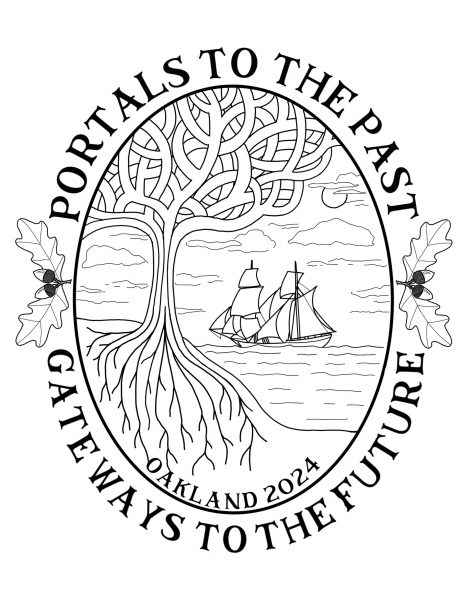9:15am - 9:30amMoments of Ambiguity: Using Jesuit Rings to Highlight Periods of Cultural Entanglement within the Potomac and Rappahannock River Valleys
Rebecca J Webster
St. Mary's College of Maryland, United States of America
Archaeologists studying the Chesapeake have interpreted the long 17th century as a period of certain and extended colonialism. However, by taking a sub-regional approach when examining the period, the shifts in power between Indians and settlers become more visible. In this paper, I examined the historical contexts in which three French-manufactured, copper alloy “Jesuit” rings were deposited at the Coan Hall (44NB11), Baylor (44EX5), and Heater’s Island (18FR72) sites. Through my analysis, I found that the presence of these rings on sites within the Potomac and Rappahannock River Valleys not only represented intercultural trade but the negotiation and re-negotiation of Indigenous power and status during the long 17th century.
9:30am - 9:45amA Storehouse of Architectural Inspirations and Legacies: Examining Structure 101 at St. Mary’s Fort, Maryland
Travis G. Parno, Henry M. Miller, Jessica Edwards
Historic St. Mary's City, United States of America
Over the past three years, archaeologists at Historic St. Mary’s City have revealed the footprint of a large, timber-framed building—dubbed Structure 101—located within the palisaded walls of St. Mary’s Fort (ca. 1634). Comprised of more than 70 posts and featuring a large cellar on its north end, Structure 101 played an important role in the earliest period of the colonial venture. As perhaps the first major structure erected by the English in Maryland, it is a puzzle to identify its inspirations as well as its intended purpose. This paper compares Structure 101’s architecture with that of medieval precedents in England and 17th-century buildings in St. Mary’s City and throughout the Chesapeake. In doing so, it seeks to locate architectural ancestors and offspring, positioning Structure 101 within the broader architectural conversation taking place in the 17th-century Chesapeake.
9:45am - 10:00amPosts or Sills – What’s The Big Deal?
Scott Strickland, Patricia Samford
Maryland Archaeological Conservation Lab, United States of America
This paper examines two colonial sites in Maryland’s Patuxent River Valley: the Melon Field site (18CV169), home of Robert Taylor Jr., dating between the 1660s and the 1680s and the 1690 to 1711 King’s Reach Site (18CV83), home of Richard Smith Jr. While these two small tobacco farms both have small structures containing multiple subfloor pits typical of early Chesapeake plantations, the sites differ significantly in building construction techniques. The King’s Reach structures were post in the ground, a building method typical of early Chesapeake construction and familiar to Chesapeake archaeologists. Robert Taylor’s home and outbuildings likely used ground sill construction. The two sites are separated by approximately 1,000 feet in distance and in time by only a few decades. Contrasting Taylor and Smith using documentary records provides further clues to the choices made by these men when constructing their homes.
10:00am - 10:30am15min presentation + 15min breakPatterns in Local and Global Coarse Earthenware Sources in the Early Colonial Chesapeake
Elizabeth A Bollwerk1, Lindsay C Bloch2
1Thomas Jefferson Foundation/Monticello; 2Tempered Archaeological Services, LLC
Locally produced, lead-glazed coarse earthenware ceramics are ubiquitous in archaeological assemblages from Chesapeake households. Between the 17th-19th centuries, ceramic industries in Philadelphia, Baltimore, Alexandria, and eastern Virginia thrived despite the popularity of imported European ceramics, and consumers of all types—enslaved, free, poor, and elite— sought locally-made coarse earthenware for food preparation, serving, and storage. Recent research has contextualized local coarse earthenware production and use in the 18th century using attribute and compositional data. We broaden this work by analyzing locally produced and imported sherds from four 17th century sites excavated at Flowerdew Hundred, a 1000-acre plantation tract located on the southside of the James River in Virginia. Comparing Flowerdew ceramics with data from 10 additional Chesapeake sites in the Digital Archaeological Archive of Comparative Slavery (DAACS), highlights the differences in wares produced in eastern Virginia in the early 17th century with expanded production in urban areas in the 18th century.
10:30am - 10:45amRevisiting Buckley in 17th-Century Chesapeake Assemblages
Barbara J. Heath
University of Tennessee, United States of America
Most archaeologists working in the Chesapeake attribute coarse earthenware characterized by a marbled buff and red paste and dark brown to black glossy glaze to potters working in the town of Buckley in northeast Wales from the 1720s through the late 18th century. Recently, Lindsay Bloch has demonstrated that wares with these characteristics were not made exclusively in Buckley, and has concurred with a few archaeologists from Maryland who have dated its appearance at their sites to the late 17th century. In this paper, I will explore the distribution of Buckley, or “Buckley-type” coarsewares within the Coan Hall Site in Northumberland County, Virginia, and between sites in southern Maryland and the Northern Neck.
10:45am - 11:30am15min presentation + 30min discussionArchival Silence, Archaeological Fluency: Finding Indigenous Slavery In The Chesapeake
Julia A King
St. Mary's College of Maryland
The capture, enslavement, and sale of Indigenous people emerged early in the colonized Chesapeake Tidewater but remains understudied by archaeologists, in part because researchers have traditionally considered Indigenous enslavement as rare in the region. I use a fragmentary archive, archaeological evidence, and oral history from the Rappahannock River valley in eastern Virginia to examine the post-1650 Anglo-Native trade in Indigenous captives and the incorporation of the colony’s tributary nations into the global market economy. Situated at the head of seagoing navigation in the river, Nanzaticos, Portobagos, Rappahannocks, and possibly Doegs established provisioning stations to supply food and guides to English traders heading into the interior. The archaeological and oral history evidence are robust, especially when compared with the limited documentary archive. Similar evidence about the Anglo-Native trade, Indigenous enslavement, and the impact on tributary nations can almost certainly be found in the Chesapeake’s other western shore river valleys.
|

